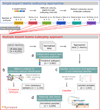The consensus molecular subtypes of colorectal cancer
- PMID: 26457759
- PMCID: PMC4636487
- DOI: 10.1038/nm.3967
The consensus molecular subtypes of colorectal cancer
Abstract
Colorectal cancer (CRC) is a frequently lethal disease with heterogeneous outcomes and drug responses. To resolve inconsistencies among the reported gene expression-based CRC classifications and facilitate clinical translation, we formed an international consortium dedicated to large-scale data sharing and analytics across expert groups. We show marked interconnectivity between six independent classification systems coalescing into four consensus molecular subtypes (CMSs) with distinguishing features: CMS1 (microsatellite instability immune, 14%), hypermutated, microsatellite unstable and strong immune activation; CMS2 (canonical, 37%), epithelial, marked WNT and MYC signaling activation; CMS3 (metabolic, 13%), epithelial and evident metabolic dysregulation; and CMS4 (mesenchymal, 23%), prominent transforming growth factor-β activation, stromal invasion and angiogenesis. Samples with mixed features (13%) possibly represent a transition phenotype or intratumoral heterogeneity. We consider the CMS groups the most robust classification system currently available for CRC-with clear biological interpretability-and the basis for future clinical stratification and subtype-based targeted interventions.
Figures





Comment in
-
Bowel cancer categorisation into four subtypes could help to guide treatment, doctors say.BMJ. 2015 Oct 12;351:h5433. doi: 10.1136/bmj.h5433. BMJ. 2015. PMID: 26463584 No abstract available.
-
Colorectal cancer subtyping.Nat Rev Cancer. 2022 Feb;22(2):68-69. doi: 10.1038/s41568-021-00432-3. Nat Rev Cancer. 2022. PMID: 34880443 No abstract available.
References
Publication types
MeSH terms
Substances
Grants and funding
LinkOut - more resources
Full Text Sources
Other Literature Sources
Medical
Molecular Biology Databases
Research Materials
Miscellaneous

